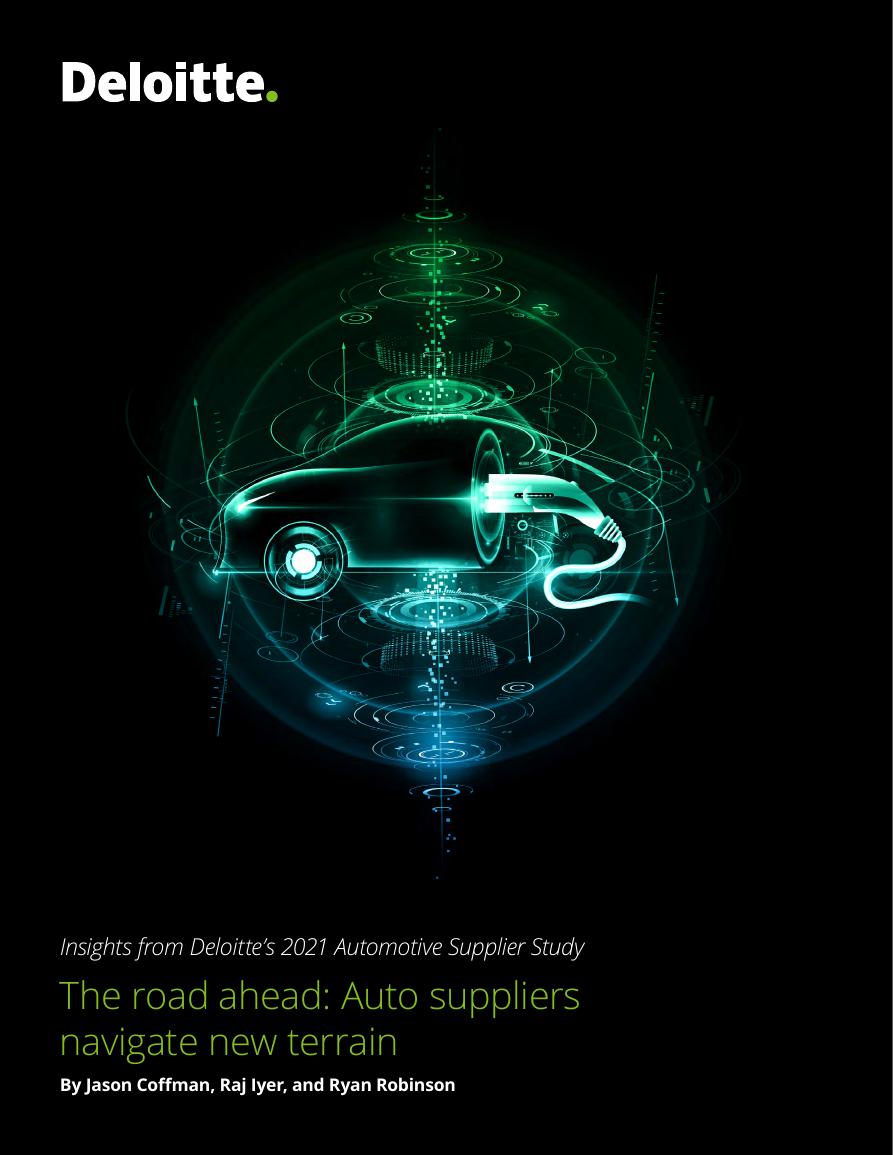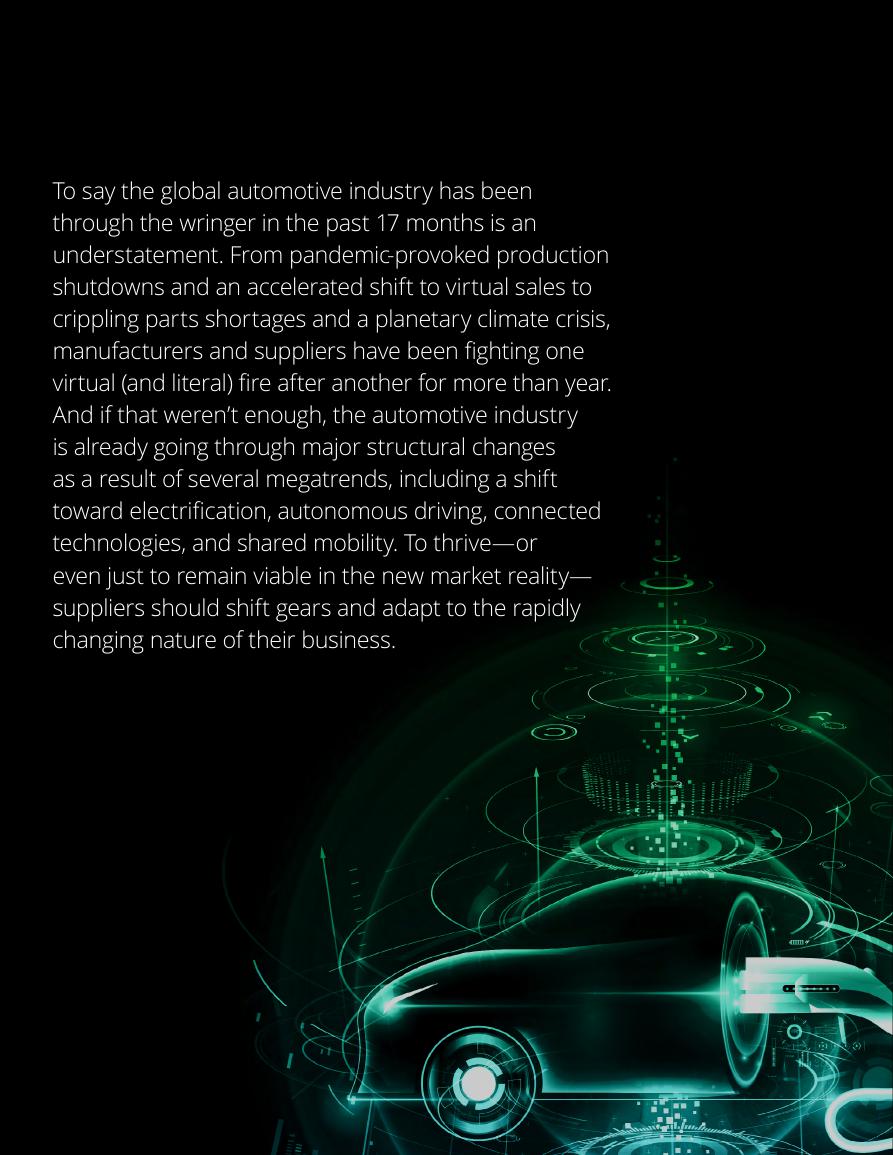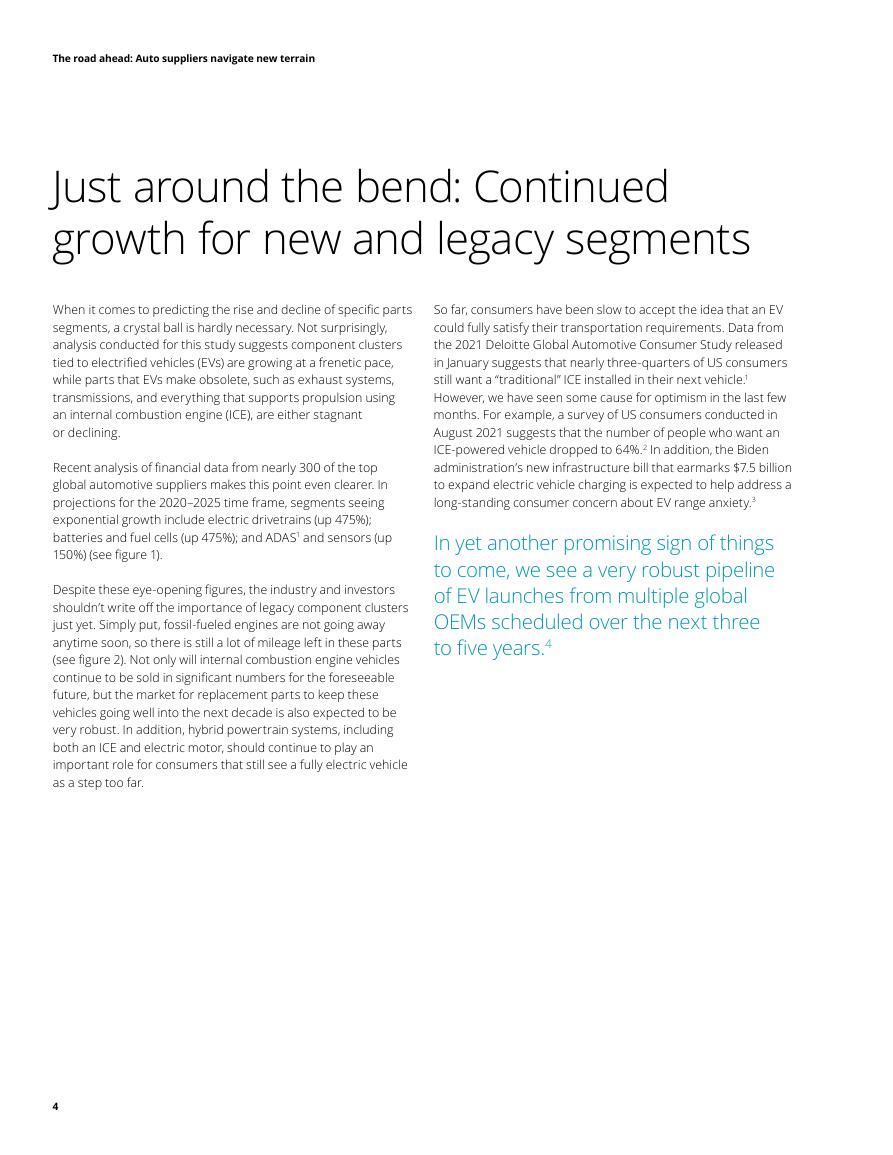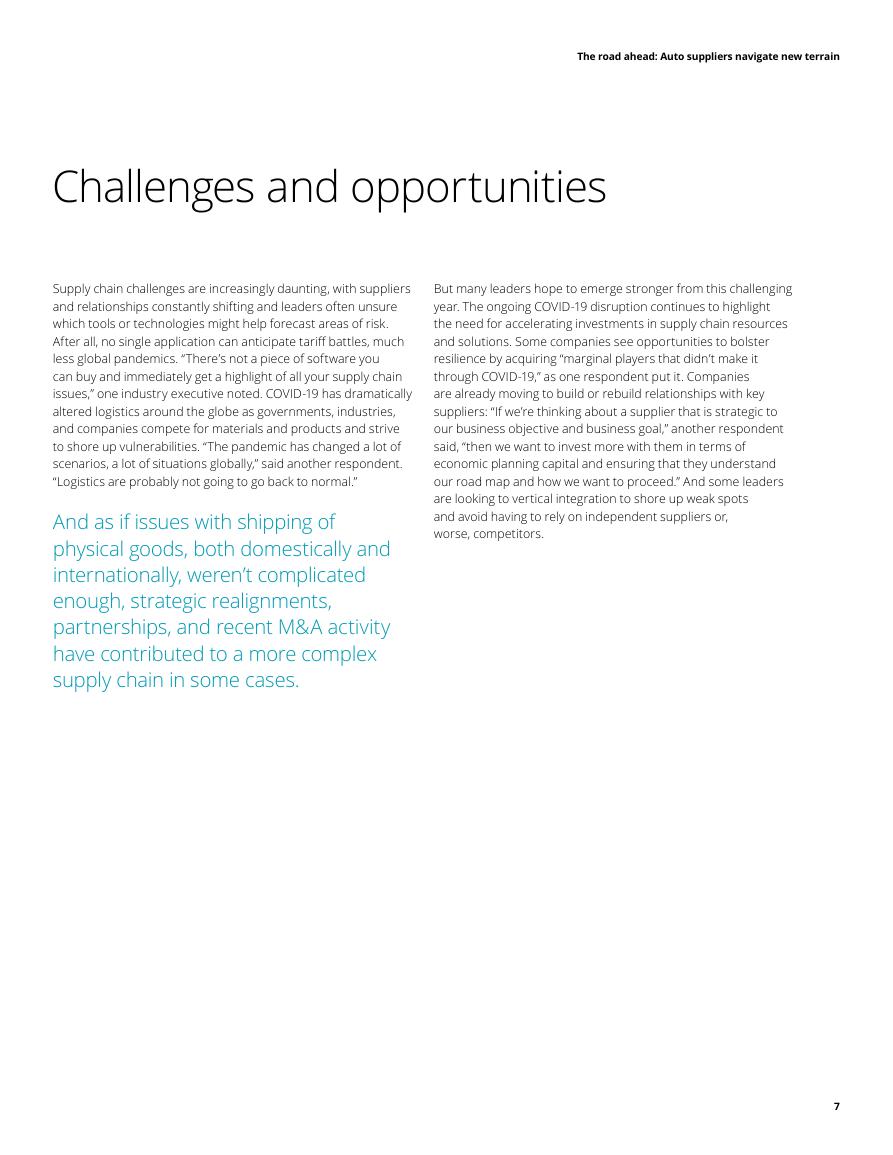01. The road ahead: Auto suppliers navigate new terrainBy Jason Coffman, Raj Iyer, and Ryan RobinsonInsights from Deloitte’s 2021 Automotive Supplier Study�
To say the global automotive industry has been
through the wringer in the past 17 months is an
understatement. From pandemic-provoked production
shutdowns and an accelerated shift to virtual sales to
crippling parts shortages and a planetary climate crisis,
manufacturers and suppliers have been fighting one
virtual (and literal) fire after another for more than year.
And if that weren’t enough, the automotive industry
is already going through major structural changes
as a result of several megatrends, including a shift
toward electrification, autonomous driving, connected
technologies, and shared mobility. To thrive—or
even just to remain viable in the new market reality—
suppliers should shift gears and adapt to the rapidly
changing nature of their business.
2
The road ahead: Auto suppliers navigate new terrain�
Introduction
As global automotive volumes have risen in the past
decade, suppliers have been emboldened to experiment
with investments in disruptive technologies, notably
electric drivetrains, vehicle connectivity, autonomous
drive, and shared mobility. In effect, by doing so, they
could disrupt their traditional business models from the
inside and potentially set themselves up for future growth.
With any or all of these technologies poised for wider-scale
adoption, suppliers had the luxuries of time and access to
relatively cheap capital to see where these investments
might lead.
Today, the time to experiment with one or more of these
disruptive technologies is quickly coming to an end.
Suppliers face a variety of new challenges, not the least of
which includes a very near-term goal laid out by several
countries to completely transform the way vehicles
operate and the fuel they consume. And while a decade
seems to provide a long runway, 10 years roughly equates
to only two vehicle cycles. When measured in terms of the
magnitude of change needed for the task ahead, this really
isn’t a lot of time.
Compounding this problem even further, the industry
has run into a massive financial jam resulting from a
combination of economic shutdowns in 2020 and 2021
and the continuing semiconductor crisis, with the risk
of other raw material shortages looming large on the
horizon. Unfortunately, with no end in sight, the continuing
chip shortage is challenging businesses to sustain
operations in the face of mounting costs and severe
revenue loss. Under such uncertain conditions, suppliers
should begin to consolidate their investments into truly
viable technologies while recognizing the importance
of these bets relative to the significant valuations new
technologies are encouraging in the market. Making
these more meaningful decisions about which road to
follow could have ramifications for the next decade—
and potentially beyond.
3
The road ahead: Auto suppliers navigate new terrain�
Just around the bend: Continued
growth for new and legacy segments
So far, consumers have been slow to accept the idea that an EV
could fully satisfy their transportation requirements. Data from
the 2021 Deloitte Global Automotive Consumer Study released
in January suggests that nearly three-quarters of US consumers
still want a “traditional” ICE installed in their next vehicle.1
However, we have seen some cause for optimism in the last few
months. For example, a survey of US consumers conducted in
August 2021 suggests that the number of people who want an
ICE-powered vehicle dropped to 64%.2 In addition, the Biden
administration’s new infrastructure bill that earmarks $7.5 billion
to expand electric vehicle charging is expected to help address a
long-standing consumer concern about EV range anxiety.3
In yet another promising sign of things
to come, we see a very robust pipeline
of EV launches from multiple global
OEMs scheduled over the next three
to five years.4
When it comes to predicting the rise and decline of specific parts
segments, a crystal ball is hardly necessary. Not surprisingly,
analysis conducted for this study suggests component clusters
tied to electrified vehicles (EVs) are growing at a frenetic pace,
while parts that EVs make obsolete, such as exhaust systems,
transmissions, and everything that supports propulsion using
an internal combustion engine (ICE), are either stagnant
or declining.
Recent analysis of financial data from nearly 300 of the top
global automotive suppliers makes this point even clearer. In
projections for the 2020–2025 time frame, segments seeing
exponential growth include electric drivetrains (up 475%);
batteries and fuel cells (up 475%); and ADAS1 and sensors (up
150%) (see figure 1).
Despite these eye-opening figures, the industry and investors
shouldn’t write off the importance of legacy component clusters
just yet. Simply put, fossil-fueled engines are not going away
anytime soon, so there is still a lot of mileage left in these parts
(see figure 2). Not only will internal combustion engine vehicles
continue to be sold in significant numbers for the foreseeable
future, but the market for replacement parts to keep these
vehicles going well into the next decade is also expected to be
very robust. In addition, hybrid powertrain systems, including
both an ICE and electric motor, should continue to play an
important role for consumers that still see a fully electric vehicle
as a step too far.
4
The road ahead: Auto suppliers navigate new terrain�
Figure 1. Automotive component segment growth (2020–2025)
Growth
Total segment revenue expected to
grow at higher rate than the volume
of vehicles sold from 2020 to 2025
Stagnant
Total segment revenue expected to
grow at the same rate as volume of
vehicles sold from 2020 to 2025
Declining
Total segment revenue
expected to shrink from 2020
to 2025
475% 475%
150%
i
n
a
r
t
e
v
i
r
d
c
i
r
t
c
e
E
l
l
l
e
c
l
e
u
f
d
n
a
y
r
e
t
t
a
B
s
r
o
s
n
e
s
d
n
a
S
A
D
A
Source: Deloitte analysis.
22% 21% 21% 18% 10% 10% 9%
9%
9%
9%
6%
-5% -10% -15% -15% -15%
l
o
r
t
n
o
c
e
t
a
m
i
l
C
s
e
r
i
t
d
n
a
s
e
e
h
W
l
s
r
o
i
r
e
t
n
I
y
d
o
B
s
t
a
e
S
i
s
c
n
o
r
t
c
e
E
l
i
s
n
o
i
t
a
c
n
u
m
m
o
c
I
d
n
a
o
f
n
i
n
o
s
n
e
p
s
u
S
e
m
a
r
F
g
n
i
r
e
e
t
S
l
s
e
x
A
s
e
k
a
r
B
m
e
t
s
y
s
t
s
u
a
h
x
E
m
e
t
s
y
s
l
e
u
F
E
C
I
i
i
n
o
s
s
m
s
n
a
r
T
Figure 2. Automotive component segment size in $B (2020 versus 2025)
Market size in 2020
Market size in 2025
$11
$11
$34
$64
$64
$84
$93
$75
$154
$144
$190
$126
$122
$76
$62
$173
$60
$66
$100
$144
$9
$8
$26
$29
$17
$18
$12
$19
$20
$11
$23
$30
$21
$25
$20
$17
$110
$123
475%
475%
150%
22%
21%
21%
18%
10%
10%
10%
9%
9%
9%
9%
-5%
-10%
-15%
-15%
-15%
Growth
Stagnant
Declining
Electric drivetrain
Battery and fuel cell
ADAS and sensors
Electronics
Interiors
Climate control
Wheels and tires
Body
Seats
Axles
Info and communications
Frame
Suspension
Steering
Brakes
Transmission
Exhaust system
ICE
Fuel system
Source: Deloitte analysis.
5
The road ahead: Auto suppliers navigate new terrain�
How did we get here?
The semiconductor crisis, in particular, continues to be a major
concern for stakeholders across the supply chain. Several
manufacturers have recently been forced to shutter North
American vehicle assembly facilities due to the chip shortage.7
Supply concerns also extend to other commodities necessary
for the production of EV batteries, including lithium, cobalt, and
nickel.8 No resources? No batteries. No EVs. At the very least,
raw material supply constraints may keep EV prices high, limiting
market penetration.
Clearly, there is no shortage of change in the industry today.
In Deloitte’s last supplier survey in 2019, we noted four forces
bearing on the industry: volume headwinds, shared mobility,
traditional value chain disruption, and vehicle content
disruption.5 This year, we believe that supply chain is displacing
shared mobility from this list of four forces. There are also new
forces at work right now, including COVID-19, the advent of
remote work and its impact on suppliers and the workforce, and
city-center disruption, that will likely slow shared mobility over
the next five years. The volume and mix of EVs across the globe
have also grown, spurring high-tech products and services to
emerge as alternatives to traditional business models.
Even in long-entrenched segments, change is happening.
For example, we believe that the current environment in the
semiconductor space will help force suppliers to finally tackle
some of the big issues that have been percolating just below the
surface for decades.6 These include a nearly complete lack of
visibility across the supply chain, aging IT systems that prevent
a free flow of information, and an erosion of trust between
manufacturers and their suppliers.
6
The road ahead: Auto suppliers navigate new terrain�
Challenges and opportunities
But many leaders hope to emerge stronger from this challenging
year. The ongoing COVID-19 disruption continues to highlight
the need for accelerating investments in supply chain resources
and solutions. Some companies see opportunities to bolster
resilience by acquiring “marginal players that didn’t make it
through COVID-19,” as one respondent put it. Companies
are already moving to build or rebuild relationships with key
suppliers: “If we’re thinking about a supplier that is strategic to
our business objective and business goal,” another respondent
said, “then we want to invest more with them in terms of
economic planning capital and ensuring that they understand
our road map and how we want to proceed.” And some leaders
are looking to vertical integration to shore up weak spots
and avoid having to rely on independent suppliers or,
worse, competitors.
Supply chain challenges are increasingly daunting, with suppliers
and relationships constantly shifting and leaders often unsure
which tools or technologies might help forecast areas of risk.
After all, no single application can anticipate tariff battles, much
less global pandemics. “There’s not a piece of software you
can buy and immediately get a highlight of all your supply chain
issues,” one industry executive noted. COVID-19 has dramatically
altered logistics around the globe as governments, industries,
and companies compete for materials and products and strive
to shore up vulnerabilities. “The pandemic has changed a lot of
scenarios, a lot of situations globally,” said another respondent.
“Logistics are probably not going to go back to normal.”
And as if issues with shipping of
physical goods, both domestically and
internationally, weren’t complicated
enough, strategic realignments,
partnerships, and recent M&A activity
have contributed to a more complex
supply chain in some cases.
7
The road ahead: Auto suppliers navigate new terrain�
Making decisions that count
Despite recent setbacks in the industry, we believe that now is
still the time for suppliers to plan for the future. With a wave of
new technologies either available today or looming large on the
horizon, suppliers should focus on adequately preparing for
what’s to come.
Supply chain effectiveness:
New thinking applied to old problems
When it comes to supply chain footprint, there is ongoing
friction. Suppliers are forced to contend with a variety of issues
at multiple levels, notably global-versus-regional tensions,
complexity, visibility, and talent scarcity.
Global-versus-regional: Suppliers should focus their attention
on several issues, including economics, trade, and geopolitical
tensions, that can lead to the adoption of nationalistic agendas.
All too often, such policies collide with globalized industries,
such as automotive, which have expanded over several decades
to encompass manufacturers, suppliers, and distributors
around the world. Trying to untangle these longstanding (and
profitable) relationships completely would be difficult, to say
the least. Having said that, suppliers should strive for more
regional self-sufficiency, minimizing production uncertainty while
strengthening their ability to wind down a dependence on costly
expedited freight due to the fragility of a global supply chain.
Complexity: Beyond the global-regional issues that suppliers
face, there is great complexity within the industry that affects
suppliers in two ways. First, precision in and coordination with
suppliers, manufacturers, and retailers keeps the industry
motoring ahead. If any one of the three legs of the industry falls
short, the ramifications are immediate and impactful for the
other two. Parts shortages, demand swings, and other examples
of volatility that we’ve seen in the past year offer a cautionary
tale for the automotive industry: It’s “all for one; one for all,”
whether the players realize it or not.9
Suppliers also should manage a second level of complexity
around the reduction of complicated OEM production as they
chase less buildable combinations to improve quality and
margins, both of which can affect a supplier’s business model
and bottom line.
8
Visibility: Your data can be your greatest asset if you have
visibility into how it’s working for you. But suppliers should figure
out their data issues right now. How they position themselves
to take full advantage of their data, making use of more reliable
demand forecasting across the manufacturing value chain, can
be vital to a successful future. This can require considerable
effort to help ensure a proper flow of data and other essential
information to facilitate real-time decision-making and greater
transparency to help manage perceived risks and rewards for
the business.
Suppliers can also benefit from improved visibility into on-vehicle
product performance. This requires working directly with OEMs
to develop data transparency to help manage performance,
quality, and warranties, which, in turn, can foster clearer insights
into the customer experience—a win-win-win experience for
suppliers, OEMs, and customers.
Talent scarcity: Suppliers are facing unprecedented shortages
of both white- and blue-collar talent today and into the future.
On the white-collar side, there is an acute and growing need
for software talent, particularly as it relates to advancing EVs.10
On the blue-collar side, the manufacturing industry has been
relentlessly challenged by a persistent skills gap and the more
recent difficulty of returning workers from COVID-19 lockdowns.
Compounding these issues is a need for attention paid to
diversity, equity, and inclusion (DE&I) across the automotive
sector. Recent study results suggest nearly half of women
working in the auto industry would choose another sector if they
had a chance to start their career over.11
When it comes to the skills gap, the numbers are daunting.
According to our latest survey, 77% of manufacturers expect
ongoing difficulties in attracting and retaining workers in 2021
and beyond. Advanced technologies, such as automation and
artificial intelligence, can help, but won’t solve the problem
outright. In fact, US manufacturers expect this problem to
continue and anticipate having 2.1 million unfilled jobs by 2030.12
The pandemic is also complicating efforts among workers
at assembly and auto parts plants in the United States. For
example, a requirement for all factory workers to wear masks
has been reintroduced shortly after being relaxed and will
remain in place until further notice due to the threat posed by
the Delta variant of COVID-19.13
The road ahead: Auto suppliers navigate new terrain�
















 V2版本原理图(Capacitive-Fingerprint-Reader-Schematic_V2).pdf
V2版本原理图(Capacitive-Fingerprint-Reader-Schematic_V2).pdf 摄像头工作原理.doc
摄像头工作原理.doc VL53L0X简要说明(En.FLVL53L00216).pdf
VL53L0X简要说明(En.FLVL53L00216).pdf 原理图(DVK720-Schematic).pdf
原理图(DVK720-Schematic).pdf 原理图(Pico-Clock-Green-Schdoc).pdf
原理图(Pico-Clock-Green-Schdoc).pdf 原理图(RS485-CAN-HAT-B-schematic).pdf
原理图(RS485-CAN-HAT-B-schematic).pdf File:SIM7500_SIM7600_SIM7800 Series_SSL_Application Note_V2.00.pdf
File:SIM7500_SIM7600_SIM7800 Series_SSL_Application Note_V2.00.pdf ADS1263(Ads1262).pdf
ADS1263(Ads1262).pdf 原理图(Open429Z-D-Schematic).pdf
原理图(Open429Z-D-Schematic).pdf 用户手册(Capacitive_Fingerprint_Reader_User_Manual_CN).pdf
用户手册(Capacitive_Fingerprint_Reader_User_Manual_CN).pdf CY7C68013A(英文版)(CY7C68013A).pdf
CY7C68013A(英文版)(CY7C68013A).pdf TechnicalReference_Dem.pdf
TechnicalReference_Dem.pdf